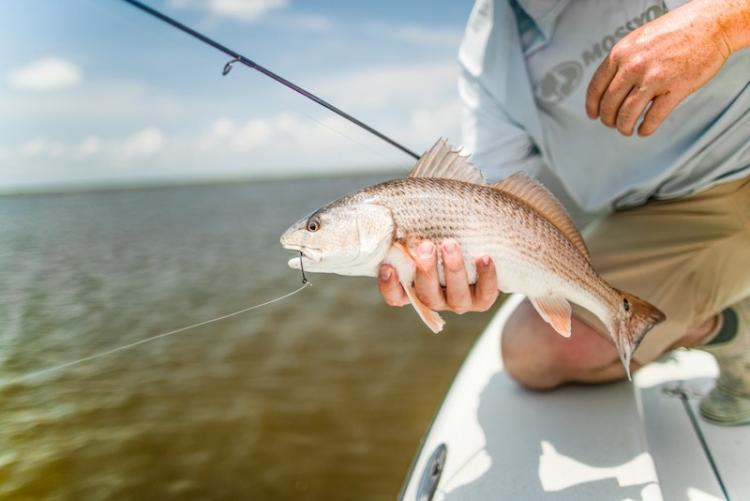No matter if you call them redfish, red drum, channel bass or any one of a handful of local nicknames, Sciaenops ocellatus is a favorite gamefish for nearly all anglers fishing in the salty inshore waters of the South. They’re even the saltwater gamefish of North Carolina, thanks to their incredible popularity in the Old North State. Reds are usually aggressive and willing to attack a wide variety of artificial lures—including topwaters—as well as a slew of natural baits as well. They fight hard and are also very good on the table at the end of the day, too. Here are five top destinations to cross paths with a redfish or ten.
BEST PLACES TO FISH FOR REDFISH IN THE U.S.
MOREHEAD CITY, NORTH CAROLINA
While the entire state has very good fishing for red drum, the region of Morehead City and the neighboring towns of Atlantic Beach and Beaufort, has arguably the best in the state. There’s easy access to the vast expanses of marshland which redfish thrive, including countless oyster bars which act as not just havens for baitfish but also provide cover for reds. Diet studies have shown that red drum are opportunistic feeders, eating crabs, shrimp and fish, but that a significant portion of their diet consist of mud crabs, which are prevalent around oyster beds, as well as small blue crabs. With that in mind, a Gulp! style soft plastic crab is a top choice for Carolina reds. A live finger mullet rigged on a small circle hook is always a top producer as well.
CHARLESTON, SOUTH CAROLINA
While redfish can be caught year-round in the marshes of South Carolina’s Lowcountry region, significant concentrations can be found in the waters surrounding the historic city of Charleston, perhaps more here than anywhere else in the state. As the water warms in the spring, the fishing heats up as well, with big schools of redfish transitioning from the creeks and oyster beds to the marshes with the rise and fall of the tides, pursuing a variety of small crabs and baitfish. There are three keys to spotting feeding reds this region: tails, muds and pushing water. The first refers to a plume of mud or sand caused when a redfish spooks in shallow water. Move quietly and carefully and you’re likely to locate more. Pushes are the vee-shaped wakes of one or more reds moving through the water and are much different from those caused by mullet or other baitfish species. Be sure to lead a pushing fish by several feet to avoid spooking it. Tailing fish are actively feeding reds that have their noses buried in the bottom, exposing the top part of the tail. Approach with caution and cast well beyond tailers to avoid spooking them.
SEBASTIAN INLET, FLORIDA
With the mangrove-lined waters of the famed Indian River Lagoon to the west and the confluence with the Indian and St. Sebastian rivers, this East Coast hot spot is famed for its fishing for nearly every inshore species. The jetties of Sebastian Inlet proper offer land-based anglers plenty of fishing opportunities around the clock, and during the spring and fall that generally means redfish are the name of the game. Research has shown that by the time reds mature to fully grown adulthood, their diet has transitioned from crustaceans to primarily finfish—time to match the hatch. A cast net can help tremendously in acquiring live bait, with finger- to palm-sized mullet at the very top of the list. Fish them a variety of ways, from freelining in the current to using a weighted Carolina or knocker-style rig. A bonus: they’ll also attract bites from just about everything else that swims in these waters, including snook and tarpon.
VENICE, LOUISIANA
It’s been called the Redfish Capital of the World, and for good reason: the sportsman’s paradise of Venice, Louisiana, has some of the very best angling for this species found anywhere on the planet. This is where the mighty Mississippi River meets the Gulf of Mexico, with thousands of square miles of marshy estuaries to explore and fish. These brackish waters hold reds ranging from smaller schoolies all the way up to 25- and 30-pound bulls that can put on a tackle-testing display of power when hooked up (the state record redfish, a 61-pounder, was caught by an angler fishing out of Venice in June 1992). Perhaps even better, these fish love artificial lures and they also bite year-round. There are plenty of top-shelf guides fishing here to put you on that trophy redfish of a lifetime.
LAGUNA MADRE, TEXAS
While the entire coast of the Lone Star State holds redfish in good numbers, one of the more unique fisheries is in the southern part of the coast and is centered around the Laguna Madre estuary. While many think of the Laguna Madre for its excellent spotted seatrout fishing, the numbers of red drum here have exploded over the past few years thanks to some excellent management by the Texas Parks and Wildlife Division over the last three decades. Due to its higher-than-usual salinity, there are fewer oyster banks located there, with most of the natural structure consisting of rocky coral and grass flats. Two top techniques are fan-casting with a gold spoon to cover some water and using a popping cork with an artificial scented shrimp. Twitch and pop the cork occasionally and it will produce bites from any reds in the area.
One species and five top destinations that are sure to produce.
-Sam White










